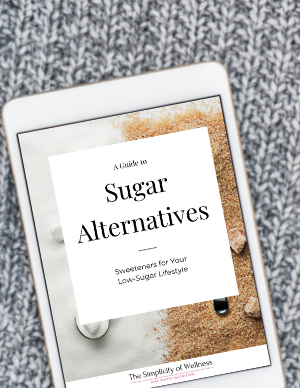Low Sugar Life
Are you making an effort to reduce the amount of sugar you put in your body? Yes?
Congratulations!!
Reducing the amount of sugar you eat is one of the easiest and best things you can do to improve your overall health unfortunately not all low-carb sweeteners are a good choice. For example, agave, don’t be fooled.
In this post I’m going to explain why a ‘low glycemic’ sweetener like Agave isn’t a great choice if overall health is your goal.
When it comes to sweeteners, your health isn’t just about controlling your blood sugar level.
Before we move on, if health is your focus check out my blog post: Know Your Health Markers.
Fructose
Fructose is a type of sugar, which is found in many foods. The liver converts fructose into glucose for use by the body. However, the liver’s capacity to convert fructose is limited and may lead to an accumulation of fructose in the liver.
In his book, The Obesity Code, Dr. Jason Fung describes fructose as ‘the most dangerous sugar’ and says ‘fructose does not raise blood sugar appreciably, yet is even more strongly linked to obesity and diabetes than glucose’. (Fung, p. 161)
Fructose seems like a ‘healthy’ sweetener because it’s the main form of sugar in fruit and fruit is healthy, right?
Well, here’s the thing, the fruit of today is not the fruit of the past. It has been cultivated to be bigger and sweeter than anything that used to grow naturally. Look at the beautiful, organic, naturally grown apple from the 100+ year old tree at our cottage. It doesn’t even fill up my palm. Compare that to what you find at the grocery store.

Giant, super-sweet fruit combined with the huge hit of fructose we get in the many manufactured, common foods of today (high-fructose corn syrup as the primary sweetener) and it’s clear that the amount of fructose we eat has increased (a lot) over the years.
Fructose vs. Glucose
Just about every cell in the body can use glucose as a fuel which means it CAN be dispersed throughout the body. ‘No cell has the ability to use fructose’. (Fung, p. 163) The only way fructose can be metabolized in the body is through the liver.
Your liver is a very busy organ. Excess fructose puts a lot of stress on an already over taxed organ. Once in the liver, fructose is metabolized into glucose and lactose (two sugars) as well as glycogen (storage form of glucose).
The body has two ways of dealing with excess glucose – storing it as glycogen (tiny storage space) and turning it into fat so it can be stored in our giant, long-term storage area (fat cells). This is not the case with fructose. ‘The more you eat the more you metabolize. The bottom line is that excess fructose IS changed into fat in the liver. High levels of fructose will cause fatty liver.’ (Fung, p. 164)
Fatty Liver (NAFLD)
Fatty liver disease is an inflammation of the liver caused by excessive fat accumulation in the organ.
In 1976, scientists first started to realize that excess sugar in the diet could cause health problems. In 1980, they discovered that high levels of triglycerides (a type of fat) can lead to atherosclerosis, which narrows arteries and can lead to heart attack or stroke. In 1985, animal research demonstrated that sugar can cause non-alcoholic fatty liver disease (NAFLD). Research has shown that NAFLD not only increases triglycerides but also increases LDL cholesterol levels as well as damaging other tissues throughout the body.
Agave

This brings me back to Agave as a ‘healthy’ sweetener.
Yes, Agave is a low-glycemic sweetener which tends to cause it to pop up as a healthy option in the low-carb world. It starts to look even better because it’s considered more of a ‘natural’ sweetener since it comes from the agave plant. For these reasons it was originally believed to be a healthier alternative to sugar.
However, once you realize that Agave is mostly FRUCTOSE (80%) and you understand the ill-health effects of excessive fructose Agave starts to lose its shine.
These days, most consider high fructose corn syrup something to be avoided. Here’s the thing, Agave has MORE fructose than high fructose corn syrup. HFCS is only 50% fructose. Crazy right!
Recap
- The glycemic impact of a food isn’t the only way it can negatively impact body function and overall health.
- There are different types of sugar and the body metabolizes these sugars in different ways
- Fructose is a bomb that hits the liver hard
- Too much fructose can make your liver FAT and impair function
- Agave is very HIGH in fructose and best to be avoided
- Don’t trust labels. Pay attention to the sugar content in foods that are often labeled low-carb like agave nectar.
- There are many low-carb, sweeteners that are low-glycemic and better for liver health
A Gift
If you’d like to learn more about low-carb sweeteners please fill out the form below and I’ll send you my Guide to Sugar Alternatives.
Once you hit the button watch your email for the PDF guide.

I’m Amy a board certified holistic nutritionist, certified functional nutritionist and lifestyle practitioner and certified Life Coach. I help women in midlife understand the changing needs of their body so that they can stop dieting and lose weight permanently. At 56 I live what I teach. Don’t believe the story that your best years are behind you. They are not. Your best years are just starting!
